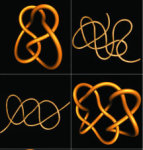
« PREVIOUS ENTRY
The death of checkers: My Times Year in Ideas piece

A couple of weeks ago, the New York Times Magazine published its 2007 “Year in Ideas” issue — their annual compendium of the year’s most interesting and offbeat research. I wrote up five of their scientific and technological entries. The entire issue is online here for free, but I’m also archiving my pieces here for posterity’s sake.
This one is about a pair of scientists that investigated the mystery of how laptop cords get tangled up so quickly when you leave them loose in your bag. Heh.
Knot Physics
When Doug Smith pulls the power cord for his laptop out of his bag, he inevitably finds that — whoops! — it has somehow tangled itself into a dense knot. This is, of course, a common complaint of the high-tech age (and before, with other types of cord). Most of us simply shrug. But Smith is a physics professor at the University of California, San Diego, and he wanted to know precisely why the knots form in the first place.
So he devised a clever experiment. Working with his research assistant Dorian Raymer, he took some string — about the thickness of a computer-mouse cord — and dropped it into a small square plastic box. They spun the box around for 10 seconds, then opened it up. Sure enough, they found “this really monster, complex knot,” Smith says. Then they repeated the experiment a dizzying 3,415 more times, using strings of different lengths and boxes of larger sizes, to see whether there were any rules that governed how badly the string knotted.
In the end, one law emerged: The longer the string, the more likely it is to form a knot. String that was 1.5 feet or shorter never got tangled up. But “as the string gets longer, the probability of a knot forming goes up and up,” Smith says, at least to 18 feet. Flexibility matters, too. The more pliable the string, the more likely it is to knot spontaneously.
Smith and Raymer then worked out the physical principles that explain why the knots form. When they programmed a computer model with these rules, it produced knots that predicted the results they got from the real-world box. In October they published their results in Proceedings of the National Academy of Sciences with a title worthy of Wallace Stevens: “Spontaneous knotting of an agitated string.”
I'm Clive Thompson, the author of Smarter Than You Think: How Technology is Changing Our Minds for the Better (Penguin Press). You can order the book now at Amazon, Barnes and Noble, Powells, Indiebound, or through your local bookstore! I'm also a contributing writer for the New York Times Magazine and a columnist for Wired magazine. Email is here or ping me via the antiquated form of AOL IM (pomeranian99).

ECHO
Erik Weissengruber
Vespaboy
Terri Senft
Tom Igoe
El Rey Del Art
Morgan Noel
Maura Johnston
Cori Eckert
Heather Gold
Andrew Hearst
Chris Allbritton
Bret Dawson
Michele Tepper
Sharyn November
Gail Jaitin
Barnaby Marshall
Frankly, I'd Rather Not
The Shifted Librarian
Ryan Bigge
Nick Denton
Howard Sherman's Nuggets
Serial Deviant
Ellen McDermott
Jeff Liu
Marc Kelsey
Chris Shieh
Iron Monkey
Diversions
Rob Toole
Donut Rock City
Ross Judson
Idle Words
J-Walk Blog
The Antic Muse
Tribblescape
Little Things
Jeff Heer
Abstract Dynamics
Snark Market
Plastic Bag
Sensory Impact
Incoming Signals
MemeFirst
MemoryCard
Majikthise
Ludonauts
Boing Boing
Slashdot
Atrios
Smart Mobs
Plastic
Ludology.org
The Feature
Gizmodo
game girl
Mindjack
Techdirt Wireless News
Corante Gaming blog
Corante Social Software blog
ECHO
SciTech Daily
Arts and Letters Daily
Textually.org
BlogPulse
Robots.net
Alan Reiter's Wireless Data Weblog
Brad DeLong
Viral Marketing Blog
Gameblogs
Slashdot Games